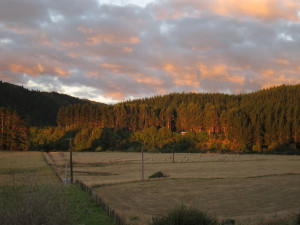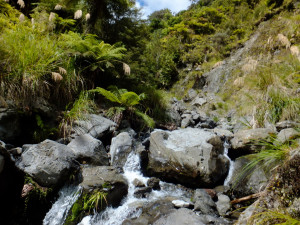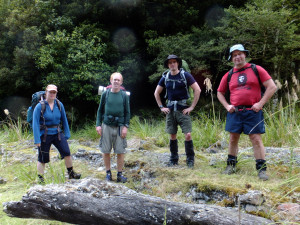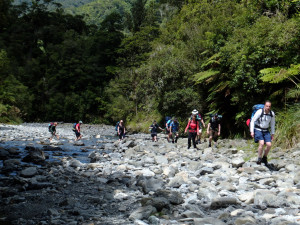 We left Wellington on a beautifully calm and sunny Friday afternoon. In fact, if you didn’t live in Wellington, you might have thought that summer had finally arrived. If the forecast was true, then most of the lower North Island would enjoy a rain-free weekend.
We left Wellington on a beautifully calm and sunny Friday afternoon. In fact, if you didn’t live in Wellington, you might have thought that summer had finally arrived. If the forecast was true, then most of the lower North Island would enjoy a rain-free weekend.
Alistair Young was going to be leading our Medium-Fit fivesome on a walk up Blackwater Stream. From the Ohau entrance to Tararua Forest Park, we’d have an hour’s stroll to our first night’s camp site from where we’d tackle the stream the next morning. Once we’d climbed to the headwaters, we’d find our way up to the ridge, then along the track to Butchers Creek, and down to South Ohau Hut. Or at least that was the plan.
The first part of the track wanders across open grassland towards the Ohau River. As we set off, the paddocks were a picture of pastoral serenity, the last rays of sunlight anointing the dry summer grass with the kind of cheap tanning cream that makes you go orange instead of brown. Yes, it was that idyllic. If there had been lambs, they would have been pronking, and goodness knows I might have pronked along with them if it hadn’t been for my pack.
After fifteen minutes, and several stiles, the track enters the bush. This section is popular with day trippers and, despite being muddy in some places, isn’t difficult. It clings to the side of the Ohau Gorge, some twenty or thirty metres above the river. It’s fairly narrow at times and it was probably a good thing that the light was fading and we couldn’t see how big the drop was.
The track eventually makes its way down to the river, and it was here, among the trees, that we stopped to make camp for the night. This patch of bush is full of paths and clearings and it was around this time that Fiona and I, returning with a billy full of water, found the track had been moved. We retraced our steps only to find that the river bank had been replaced with a similar but, we both agreed, not identical piece of river bank to the one we’d just been at. Fortunately, a few more minutes of retracing and some inspired guesswork saw the track return to its normal location and we managed the hundred metre walk back to camp without further difficulty.
 The night passed without incident or sleep. Saturday morning was fine and cool. After a quick breakfast, we packed up our flies and set off on our five hour trek up stream. The Blackwater is the Ohau River’s one major tributary and carves out a valley between Gable End Ridge and the Waiopehu Track. It’s not quite as gorgy as the Ohau but its banks are rocky and overgrown. Where there are options to walk alongside the stream, it’s usually through thistle and toetoe, so staying in the water is often the best choice. Alistair had walked the stream many times and, rather than pass on his expert knowledge, he promised to let us choose which direction to take at the five forks we’d meet along the way. I’d brought a map, and had even packed it in an easily-accessible part of my pack, but I had a suspicion I was probably the least able map reader in the group. Whatsmore, Mike already had his map and compass slung round his neck and looked every inch the experienced navigator. Which, fortunately, he was.
The night passed without incident or sleep. Saturday morning was fine and cool. After a quick breakfast, we packed up our flies and set off on our five hour trek up stream. The Blackwater is the Ohau River’s one major tributary and carves out a valley between Gable End Ridge and the Waiopehu Track. It’s not quite as gorgy as the Ohau but its banks are rocky and overgrown. Where there are options to walk alongside the stream, it’s usually through thistle and toetoe, so staying in the water is often the best choice. Alistair had walked the stream many times and, rather than pass on his expert knowledge, he promised to let us choose which direction to take at the five forks we’d meet along the way. I’d brought a map, and had even packed it in an easily-accessible part of my pack, but I had a suspicion I was probably the least able map reader in the group. Whatsmore, Mike already had his map and compass slung round his neck and looked every inch the experienced navigator. Which, fortunately, he was.
I’d made the novice tramper’s error of bringing a pack that was both too heavy and too big. No, that sounds like I’m blaming the pack. What I mean is, I’d put too much stuff in the pack so that it was both heavy and also rather tall, neither of which did me any favours on this particular Saturday. I’d done river crossings before but not a lot of there’s-a-perfectly-good-track-up-on-the-ridge-but-I’m-sure-everyone-actually-prefers river walkings before. I was glad of my sturdy boots as I clambered and slithered my way over the rocks. My pack, however, quickly proved to be my enemy. Despite its comfy suspension system, I found I was using all my energy trying to stay balanced and keep my weight forward. At every slimy boulder—and actually many of the slime-free ones—it threatened to tip me off balance. I was moving sideways more than I was moving forward.
Which probably explains why each time I glanced up the stream, I would see that the others had somehow leapt forward fifty metres in the few seconds I’d been looking at my feet. This was obviously some very special woodland magic they’d learned on one of the more advanced Bushcraft courses. Far from feeling despondent about this, however, I took it as a cue to up my game. I got my eyes out of the water, gave my legs a quick talking to, and resolved to eat the Blackwater for lunch (actual lunch being some five hours away still).
We strode, climbed and heaved our way up the stream. As the valley steepened, so the streambed narrowed and became a staircase of small waterfalls. Around this time, we encountered the first of the much-anticipated forks. Well, the forks weren’t much anticipated, rather the fact that we had to decide which way to go, knowing that we’d just have to turn round and come back if we got it wrong. Each time we had to decide on a route, we’d stop and take a vote. The first couple of votes were virtually unanimous—one way was obviously a stream, the other way was a vertigo-inducing scree slope—but things became more evenly split as we worked our way up the valley. We all looked at Alistair’s happily less-than-pokery face as we raised our hands and sealed our fate. But luck (and Alistair’s asking repeatedly, “Are you sure?”) seemed to be on our side. In any case, I was fairly confident he didn’t want to spend any more time in the Blackwater than the rest of us. Fairly confident.
 If, in fact, we’d made all the right choices about which route to take, you could have fooled me. The final stretch of stream was rough going. A lot of wind fallen trees meant we were constantly climbing over and under logs, and sometimes both at the same time. I found I would crouch right down so my pack could clear a low-lying branch, only to find myself pinned, knees tightly pressed against my chest so that I couldn’t take a step forward, and I’d have to drag myself out from under the branch with my hands. I didn’t even know if my sleeping mat—which I’d foolishly strapped to the outside of my pack—was still attached, and it was now after two o’clock which meant we’d been climbing up this stream for more than six hours. The idea of finding a ridge or even a track seemed like an impossible dream at this point, as did lunch, and, come to think of it, the avocado and cheese sandwiches I’d placed in the top of my pack so I could find them easily had probably been turned to sludge thanks to the fifty billion fallen trees I’d climbed under in the last ten minutes.
If, in fact, we’d made all the right choices about which route to take, you could have fooled me. The final stretch of stream was rough going. A lot of wind fallen trees meant we were constantly climbing over and under logs, and sometimes both at the same time. I found I would crouch right down so my pack could clear a low-lying branch, only to find myself pinned, knees tightly pressed against my chest so that I couldn’t take a step forward, and I’d have to drag myself out from under the branch with my hands. I didn’t even know if my sleeping mat—which I’d foolishly strapped to the outside of my pack—was still attached, and it was now after two o’clock which meant we’d been climbing up this stream for more than six hours. The idea of finding a ridge or even a track seemed like an impossible dream at this point, as did lunch, and, come to think of it, the avocado and cheese sandwiches I’d placed in the top of my pack so I could find them easily had probably been turned to sludge thanks to the fifty billion fallen trees I’d climbed under in the last ten minutes.
At 1,097 metres, Twin Peak provides outstanding views of the main Tararua Range to the south east, and Horowhenua and Kapiti Island to the west. I’d made it up to the ridge in a collection of pieces that, with a little encouragement, and especially some food, could probably almost be described as one. We sunned ourselves beside the track and gazed at the green, blanketed wilderness around us. Just as it was beginning to feel like we had the Tararuas to ourselves, two lightly-clad figures appeared over the horizon and trekking-poled their way toward us. They were two young women from Boston who had been walking Te Araroa and were now on the final North Island leg to Wellington. They’d started from Cape Reinga five months ago. They looked a little like they’d just stepped out of a hiking shoe catalogue. I envied their modest-sized packs and dry feet and well-supported knees and the fact that their fingers weren’t covered in cutty grass cuts. Whatever I might have said to that effect never came out because I was lying on my back and couldn’t move. After a brief chat, they poled off down the track, I assume to get on with the South Island.
 Our plan for the afternoon was to continue along the ridge to Richard’s Knob, then on to Dora Track as far as Butchers Saddle. At Butchers Saddle, we’d drop off the track into Butchers Creek and work our way down to South Ohau Hut “sidling a few waterfalls along the way”. Once again, looking at the map, there seemed to be a perfectly serviceable track along the ridge above Butchers Creek, a track that, rather conveniently I thought, also led to South Ohau Hut. But then the others in the group may have been tired from using their advanced bushcraft skills and hadn’t noticed this on the map. In any case, we’d conquered Blackwater Stream. What was a mere creek? I remember feeling a certain elation as we headed off once more, elation because we were on dry land, and because we were going downhill. This didn’t last long as I realised the battle with the Blackwater had taken much of the supportive spring out of my step. And despite having eaten my avocado and cheese sandwiches, my pack didn’t feel any lighter.
Our plan for the afternoon was to continue along the ridge to Richard’s Knob, then on to Dora Track as far as Butchers Saddle. At Butchers Saddle, we’d drop off the track into Butchers Creek and work our way down to South Ohau Hut “sidling a few waterfalls along the way”. Once again, looking at the map, there seemed to be a perfectly serviceable track along the ridge above Butchers Creek, a track that, rather conveniently I thought, also led to South Ohau Hut. But then the others in the group may have been tired from using their advanced bushcraft skills and hadn’t noticed this on the map. In any case, we’d conquered Blackwater Stream. What was a mere creek? I remember feeling a certain elation as we headed off once more, elation because we were on dry land, and because we were going downhill. This didn’t last long as I realised the battle with the Blackwater had taken much of the supportive spring out of my step. And despite having eaten my avocado and cheese sandwiches, my pack didn’t feel any lighter.
After another hour, we reached the saddle. I couldn’t really tell you if things looked promising as we dropped off the track and back into the bush. If there’d been any hope of making it down the creek to the hut to begin with, then it started to fade as the creek bed dropped away below us, its sides becoming steeper and steeper, the surrounding undergrowth thicker and thicker. We tried in vain to find a route on one side, then the other, although actually getting from one side to the other was no small task. The terrain was the kind that really isn’t designed for someone wearing a backpack. Or for someone not wearing a backpack.
The afternoon was shutting down its computer and the evening had punched in and was already logged on to facebook by the time it was decided to abandon Butchers Creek. I don’t know how close we’d got to seeing the hut but I don’t think it was very. We’d gone far enough, though, that the ridge we were now going to clamber back up to (the one I’d seen on the map, the one with the track that led to the hut we wanted to go to) was more than one hundred metres above us. There was nothing for it but to go straight up the guts. Despite my efforts throughout the day to hide my struggle with my pack, my companions’ advanced woodland telepathy had allowed them to pick up on my discomfort. Somehow it was decided that Andy and I should swap luggage. I felt like I should protest on Andy’s behalf, although not too much in case the swap didn’t happen. He seemed happy enough with the deal, and I admit I wasn’t exactly inconvenienced by it. And so, with the idea of freeing ourselves once and for all of the undergrowth and getting back to relative civilisation and possibly even dinner, we clawed our way back up to the ridge.
The walk down the ridge to the hut was a one step at a time affair, particularly the last section where Yeates Track drops steeply as it heads down to meet the South Ohau River. My knees were starting to protest ever so slightly and I kept thinking I could see an expanse of mint green corrugated iron between the trees which could only be the roof of the hut. Then someone told me the hut had a red roof. Concerned, then, that I might be hallucinating, or at least losing the plot with fatigue, I gritted my teeth, and the rest of my body, and lowered myself down the last fifty or so steps to eventually find myself standing at the front door of our riverside accommodation.
An Easy-Medium group had arrived at the hut six hours before us and had spent the afternoon sunbathing, chasing butterflies and writing haikus. When we got there, some of them were down by the river roasting marshmallows. They’d already had dinner (it now being after eight) and we were rather interested in doing the same. Now was my chance to get rid of the 500 grams of pasta I’d been hauling around all day. Fortunately, Alistair considered cooking the evening meal one of a trip leader’s responsibilities and had come prepared with a delicious homemade pasta sauce as well as ginger crunch and custard for dessert.
 The plan for the following morning was to follow the Ohau River back to where we’d camped on Friday night, then walk out along the gorge track to the road end. As the crow flies, it’s about four kilometres. As the river wiggles, maybe twice that. I had a good sleep in and woke to find most people up and eating breakfast. Rather improbably, it was another fine day. We set off just before nine o’clock, the two groups comprising about twelve trampers in total. The Ohau River terrain was fairly straight forward compared with the Blackwater, but the constant river crossings made it a decent challenge for legs that were still tired from the previous day’s workout.
The plan for the following morning was to follow the Ohau River back to where we’d camped on Friday night, then walk out along the gorge track to the road end. As the crow flies, it’s about four kilometres. As the river wiggles, maybe twice that. I had a good sleep in and woke to find most people up and eating breakfast. Rather improbably, it was another fine day. We set off just before nine o’clock, the two groups comprising about twelve trampers in total. The Ohau River terrain was fairly straight forward compared with the Blackwater, but the constant river crossings made it a decent challenge for legs that were still tired from the previous day’s workout.
The narrow gorge remained shady and cool for the first hour or two, but by eleven o’clock the sun had begun to fill the valley and people started fishing out their sun hats. An hour later, we stopped on a wide stretch of bank where the river narrowed and deepened into an inviting pool. Moments later, people were pulling off their boots and making for the water. It was an invigorating temperature and I managed to stay in for about ninety seconds before clambering out and up the bank to lie for a few minutes on the warm river stones.
The sun continued to shine and, after another half hour’s travel, we managed to locate the enormous orange triangle on the true left of the river that marked the beginning of the gorge track. We stopped for twenty minutes to have lunch, and I unlaced my boots to inspect a big toe that had been feeling rather tender that morning but was now, for better or worse, not feeling very much at all. Then, having eaten lunch, we pulled on our packs for the final push to the road end.
After clambering back along the muddy gorge track for forty minutes, we emerged from the bush into the bright afternoon sunlight. The open grassland felt like a long-lost and slightly unfamiliar friend. After nearly two days of river valleys, I had become accustomed to the ground around me only going a few metres before becoming vertical in the shape of a bank or a cliff or a waterfall. Now, though, there was undulating farmland for hundreds of metres in almost every direction.
Pronking was out of the question this time, but my legs were still able to enjoy the amble across the paddocks to the road end. Once there, I happily eased my pack to the ground and took off my boots. I sat on the grass and tried to remember what it was you’re supposed to do when you finally get to somewhere you’ve been looking forward to getting to. I didn’t manage it. Instead, I found myself thinking about the much smaller pack I would bring next time, and the unsquashable lunchbox I would keep my sandwiches in, and how I would carry my sleeping pad inside my pack, and how I would try to think about why cutty grass is called cutty grass before relying on it as a means of support. Yes, the Blackwater had taught me some important lessons, alright. It had also given me one rather blackened toenail. But I knew the knowledge I’d gained from my trip would still be there for me to use on my next tramp. The toenail, probably not.
